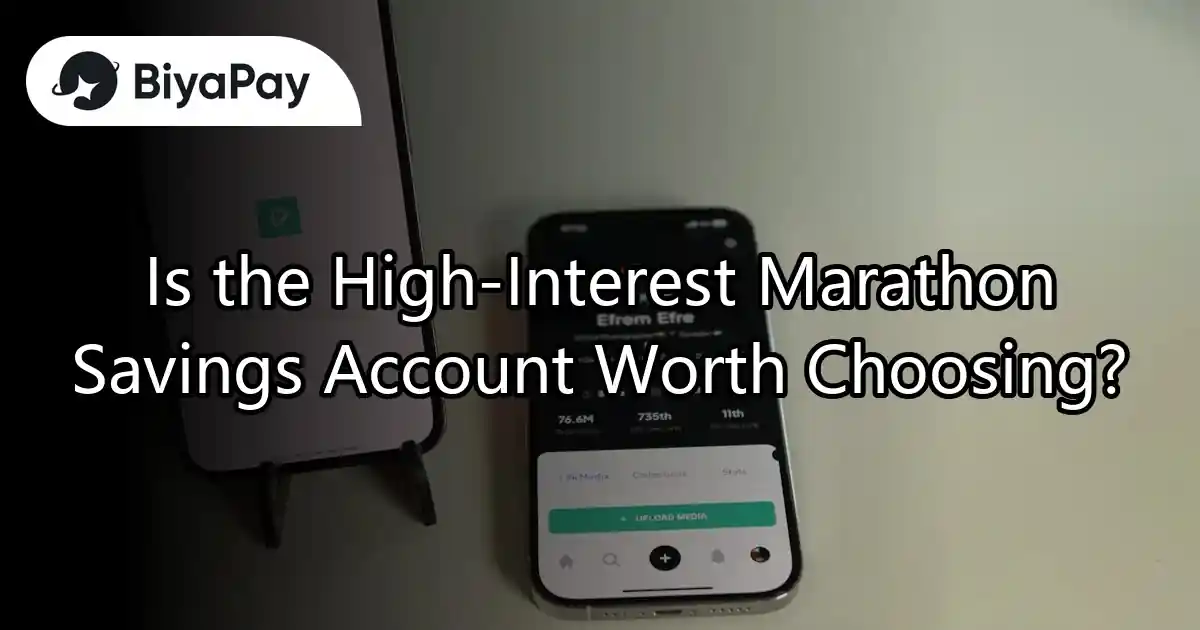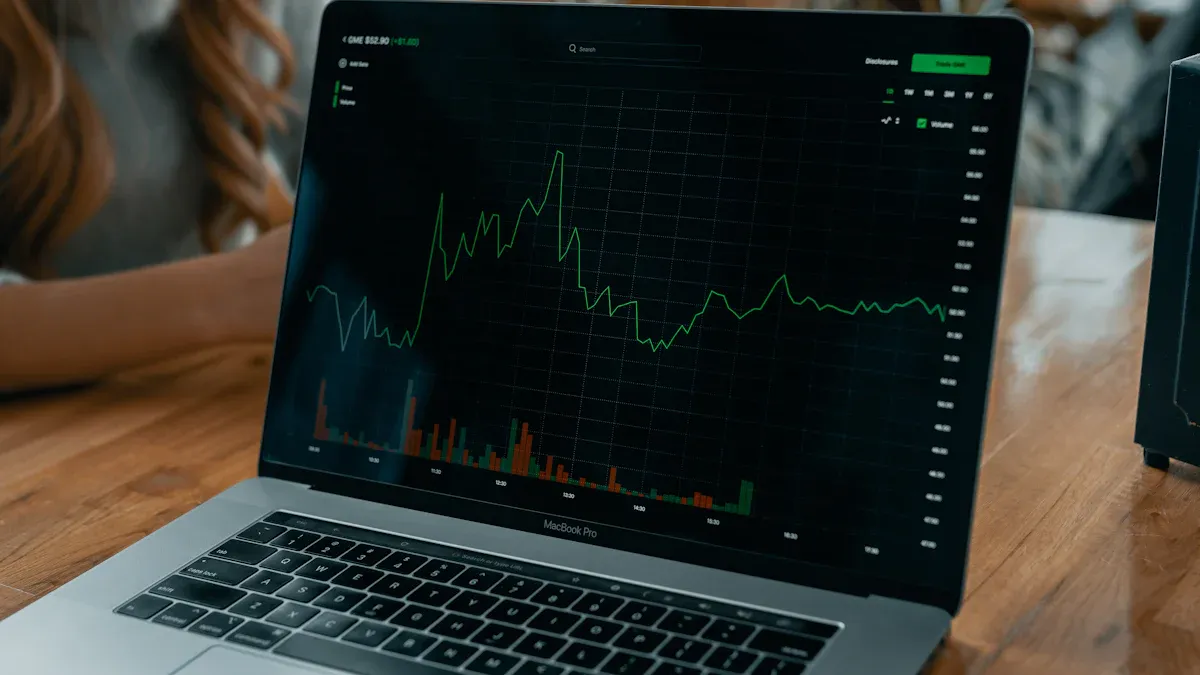- EasyCard
- Trade
- Help
- Announcement
- Academy
- SWIFT Code
- Iban Number
- Referral
- Customer Service
- Blog
- Creator
Is the High-Interest Marathon Savings Account Worth Choosing?

Image Source: unsplash
When choosing a high-interest marathon savings account, you need to comprehensively consider your financial goals. This type of account offers flexibility, allowing you to access funds at any time. Its appeal lies in the tiered high-interest rate design, suitable for short-term financial management. If you aim to achieve higher returns during the deposit period, this product may meet your needs. Understanding the interest rate details and terms can help you avoid potential risks.
Key Points
- The high-interest marathon savings account offers tiered interest rates, with rates reaching 1% or higher based on deposit amount and duration, suitable for short-term financial management.
- The flexibility of this account allows you to withdraw funds at any time without worrying about penalties, making it particularly suitable for emergency fund needs.
- When choosing this type of account, pay attention to interest rate changes after the promotional period to avoid significant declines in returns.
- Understanding the compound interest calculation method can help you maximize returns, with longer deposit periods yielding more significant compound interest effects.
- Carefully read the terms to confirm whether there are minimum deposit requirements or hidden fees to ensure your savings plan is unaffected.
The Interest Rate Appeal of the High-Interest Marathon Savings Account

Image Source: unsplash
Tiered Interest Rate Design
The core appeal of the high-interest marathon savings account lies in its tiered interest rate design. Banks offer different interest rate levels based on the customer’s deposit amount and duration, making this design not only flexible but also capable of meeting the needs of different customers.
Below are some common tiered interest rate designs:
- Customers with lower deposit amounts may receive a base interest rate of 0.1%.
- Customers with medium deposit amounts may see rates increase to 0.5%.
- Customers with high deposit amounts may enjoy rates of 1% or higher.
This tiered design not only attracts customers with varying deposit amounts but also helps banks better analyze customer behavior patterns, optimizing product design. For you, this means you can choose the most suitable interest rate plan based on your financial situation.
Comparison with Other Savings Accounts
When considering a high-interest marathon savings account, understanding its differences from other savings accounts is crucial. Below is a comparison table showing the interest rates of savings accounts and fixed-term deposits from different banks:
| Bank Type | Savings Account Rate | 3-Month Fixed Deposit Rate | 6-Month Fixed Deposit Rate | 1-Year Fixed Deposit Rate | 5-Year Fixed Deposit Rate |
|---|---|---|---|---|---|
| State-Owned Commercial Banks | 0.35% | 2.85% | 3.05% | 3.25% | 4.75% |
| Joint-Stock Banks | 0.385% | 2.86% | 3.08% | 3.30% | 4.75% |
| Foreign Banks | 0.385% | 2.86% | 3.08% | 3.30% | 4.55% |
From the table, it can be seen that the interest rates of high-interest marathon savings accounts are generally higher than traditional savings accounts but still lag behind fixed-term deposits. If your funds need to remain flexible, the high-interest marathon savings account is a good choice.
Actual Returns from High Interest Rates
How much actual return can the high interest rates of a marathon savings account generate? This depends on your deposit amount and duration. For example, if you deposit $10,000 at a 1% annual interest rate, you will earn $100 in interest after one year.
However, actual returns may be affected by the following factors:
- Promotional Period Restrictions: Some high interest rates may only apply during a specific promotional period, after which rates may decrease.
- Compound Interest Calculation: Some banks use compound interest, meaning your interest grows with the principal, further increasing returns.
Therefore, when choosing a high-interest marathon savings account, you need to carefully calculate potential returns and ensure you understand all relevant terms. This will help maximize your financial returns.
Suitable Scenarios for the High-Interest Marathon Savings Account
Short-Term Financial Management
If you are looking for a flexible short-term financial management option, the high-interest marathon savings account may be an ideal choice. This type of account allows you to freely withdraw your principal during the deposit period without incurring penalties for early withdrawal. This flexibility greatly enhances your fund liquidity, making it particularly suitable for situations where funds need to be readily accessible, such as paying unexpected expenses or short-term investments.
Additionally, compared to traditional savings accounts, the interest rates of high-interest marathon savings accounts are more attractive. Even if your funds are only deposited for a few months, you can enjoy higher returns than regular savings accounts. This is a good option for users seeking stable returns in the short term.
Flexibility for Emergency Funds
Emergency funds need to be readily available, and the high-interest marathon savings account meets this need. Its flexible withdrawal feature allows you to access funds quickly when needed, without worrying about penalties or other restrictions. This is particularly important for handling unexpected situations, such as medical expenses or family emergencies.
At the same time, this type of account helps you earn some interest while maintaining fund flexibility. Compared to leaving funds idle in a regular bank account, choosing a high-interest marathon savings account adds more value to your emergency funds.
Suitability for Long-Term Savings
While the high-interest marathon savings account is primarily suited for short-term financial management, it can also be used for long-term savings in certain cases. If you want to maintain fund flexibility while earning stable interest returns, this account may be a compromise. However, long-term savings typically require higher interest rates to achieve greater returns, so you may need to consider other options, such as fixed-term deposits or investment products.
When choosing a high-interest marathon savings account as a long-term savings tool, pay special attention to interest rate changes after the promotional period. Ensure you understand all terms and make informed decisions based on your financial goals.
Potential Risks of the High-Interest Marathon Savings Account

Image Source: unsplash
Interest Rates After the Promotional Period
The high interest rates of a marathon savings account are typically only valid during the promotional period. After the promotional period ends, the interest rate may drop significantly, possibly reverting to the level of a regular savings account. If you fail to understand the duration of the promotional period and the subsequent interest rate, it may impact your actual returns.
For example, some banks’ promotional periods may last only three months, after which the interest rate may drop from 1% to 0.1%. This means that if you plan to deposit for the long term, the low interest rate after the promotional period may significantly reduce your returns. Therefore, when choosing this type of account, carefully read the terms to understand the specific duration of the promotional period and the interest rate changes thereafter.
Impact of Compound Interest Calculation
Compound interest calculation has a significant impact on your actual returns. The feature of compound interest is that interest is calculated based on the principal and previously accumulated interest, allowing your returns to grow over time.
Below is the impact of compound interest calculation on returns:
- Compound Interest Formula: Banks typically use the formula (A = P(1 + r)^n) to calculate compound interest, where (A) is the final amount, § is the principal, ® is the interest rate, and (n) is the number of compounding periods.
- Importance of Time: The longer the deposit period, the more pronounced the compound interest effect. For example, depositing $10,000 at a 1% annual interest rate with compound interest will yield higher returns after five years compared to simple interest.
- Use of Tools: You can use EXCEL or other calculation tools to simulate the compound interest effect for different deposit periods and interest rates, helping you better plan your finances.
Compound interest can enhance your fund growth, but note that some banks may limit the frequency of compound interest calculations, such as annually or quarterly, which will affect the final returns.
Hidden Terms and Fees
The terms of a high-interest marathon savings account may include hidden fees or restrictions that could reduce your actual returns. For example, some banks may require you to maintain a minimum deposit amount, or they may charge administrative fees if the balance falls below this amount.
Below are some common hidden terms:
- Minimum Deposit Requirement: If your deposit falls below a certain amount, the bank may lower the interest rate or charge additional fees.
- Early Withdrawal Restrictions: Although this type of account typically allows flexible withdrawals, some banks may charge fees for frequent withdrawals.
- Other Fees: For example, account management fees or transaction fees may be noted in fine print and easily overlooked.
To avoid these potential risks, you should carefully read all terms and confirm with bank staff whether there are additional fees or restrictions. This ensures your savings plan remains unaffected by unexpected issues.
User Reviews and Case Studies
Common User Questions
You may be curious about the common questions other users have about high-interest marathon savings accounts. Below are some questions gathered from surveys, reflecting users’ main concerns:
- Users are concerned about whether the sample sources are sufficiently diverse. If sample sources are too singular, they may not accurately reflect market demand.
- Some users believe that relying solely on surface data cannot deeply understand consumer needs. They suggest banks adopt more comprehensive data analysis methods.
These questions highlight users’ emphasis on product transparency and the depth of data analysis. You can use this feedback to choose a savings product that better meets your needs.
Evaluation of Interest Rates and Flexibility
How do the interest rates and flexibility of high-interest marathon savings accounts perform in user evaluations? According to surveys, the following data shows the product’s performance in different use cases:
| Strategy Area | Data Source | Potential Adjustment Direction | Implementation Priority Judgment |
|---|---|---|---|
| Product Positioning Optimization | Pain Point Feedback, Competitor Comparison, Value Perception | Reordering Core Selling Points, Strengthening Differentiation | Coverage of Highly Relevant Pain Points |
| Pricing Strategy Adjustment | Price Sensitivity, Attractiveness of Different Plans | Price Point Adjustment, Package Restructuring, Early-Bird Strategy | Balance of Price Acceptance and Profit |
| Messaging Optimization | Keyword Preference, Emotional Response, Cognitive Barriers | Copy Adjustment, Visual Focus, Professionalism Adjustment | Resonance Strength with Target Audience |
| Customer Segment Prioritization | Conversion Willingness, Market Size, Acquisition Difficulty | Redefining Primary Target Audience, Multi-Segment Strategy | Balance of Scale and Conversion Potential |
| Channel Strategy Restructuring | Media Usage Habits, Information Source Preferences | Marketing Channel Mix Adjustment, Content Format Optimization | Coverage Efficiency and Cost Ratio |
These data highlight the advantages of high-interest marathon savings accounts in terms of interest rate appeal and flexibility. You can choose the appropriate strategy direction based on your needs.
Real-Life Case Studies
One user shared their experience with a high-interest marathon savings account. They deposited $20,000 at a 1% annual interest rate and withdrew part of the funds within three months to cover a family emergency. The user noted that the account’s flexibility allowed them to handle unexpected situations quickly while earning higher interest than a regular savings account.
Another user chose to keep funds in the account for six months, benefiting from compound interest for additional returns. They advised other users to carefully calculate potential returns and understand interest rate changes after the promotional period when choosing a savings product.
These cases demonstrate the practical effects of high-interest marathon savings accounts in different scenarios. You can refer to these experiences to create a savings plan based on your financial needs.
The high-interest marathon savings account is suitable for users seeking short-term high interest rates and flexibility. According to market data, the interest rates of such accounts are generally higher than regular savings accounts. For example, Standard Chartered’s “Marathon” account offers an annual interest rate of 4.44%, while regular bank savings accounts typically offer around 0.75%. Additionally, these accounts are protected by the Hong Kong Deposit Protection Scheme, with funds up to $500,000 being nearly risk-free.
However, if you have long-term savings needs, you should consider carefully. The high interest rates in the short term may not compensate for the rate drop after the promotional period. For example, some products offer tiered interest rates that increase over different stages, but rates may revert to regular levels after the promotional period. Below is an example:
| Stage | Period | HKD Annual Interest Rate | USD Annual Interest Rate |
|---|---|---|---|
| First Stage | From Account Opening to February 2, 2025 | 3.00% | 3.50% |
| Second Stage | February 3 to March 2, 2025 | 3.20% | 3.60% |
| Third Stage | March 3 to March 31, 2025 | 3.80% | 4.28% |
When choosing a high-interest marathon savings account, carefully read the terms to understand the promotional period and interest rate changes. Based on your financial needs, select the most suitable product to balance fund flexibility and returns.
FAQ
1. Is There a Minimum Deposit Requirement for High-Interest Marathon Savings Accounts?
Some banks may require a minimum deposit amount, such as $500 or $1,000. You need to confirm the specific requirements with the bank to avoid missing out on high-interest rate benefits due to insufficient deposits.
2. What Happens to the Interest Rate After the Promotional Period?
After the promotional period, the interest rate typically reverts to the level of a regular savings account, such as 0.1% to 0.35%. You should understand the duration of the promotional period and the subsequent rate changes in advance.
3. Will Early Withdrawal Affect Interest Earnings?
High-interest marathon savings accounts generally allow flexible withdrawals without penalties. However, some banks may charge fees for frequent withdrawals. You should carefully read the terms to avoid additional costs.
4. Is the High-Interest Marathon Savings Account Suitable for Long-Term Savings?
This type of account is better suited for short-term financial management. For long-term savings needs, fixed-term deposits or investment products may offer higher returns.
5. How Can I Calculate the Actual Returns of a High-Interest Marathon Savings Account?
You can use the formula (A = P(1 + r)^n), where § is the principal, ® is the annual interest rate, and (n) is the number of years. This helps you estimate returns and compare different products’ benefits.
Marathon Savings Accounts offer tiered high interest rates (up to 4.44%) and flexible withdrawals, ideal for short-term financial management, but how can you further enhance cross-border capital efficiency and wealth growth? BiyaPay provides a seamless digital financial platform, enabling trading in U.S. and Hong Kong stocks without offshore accounts, complementing the flexibility of Marathon Savings with global market opportunities.
Supporting USD, HKD, and 30+ fiat and digital currencies with real-time exchange rate transparency, plus global remittances to 190+ countries with remittance fees as low as 0.5%, it outperforms traditional banking’s costly processes. A 5.48% annualized yield savings product with no lock-in period ensures balanced returns and liquidity, addressing post-promotion rate drops. Sign up for BiyaPay today to integrate Marathon Savings with BiyaPay’s digital financial solutions for efficient, cost-effective wealth management!
*This article is provided for general information purposes and does not constitute legal, tax or other professional advice from BiyaPay or its subsidiaries and its affiliates, and it is not intended as a substitute for obtaining advice from a financial advisor or any other professional.
We make no representations, warranties or warranties, express or implied, as to the accuracy, completeness or timeliness of the contents of this publication.




Contact Us
Company and Team
BiyaPay Products
Customer Services
is a broker-dealer registered with the U.S. Securities and Exchange Commission (SEC) (No.: 802-127417), member of the Financial Industry Regulatory Authority (FINRA) (CRD: 325027), member of the Securities Investor Protection Corporation (SIPC), and regulated by FINRA and SEC.
registered with the US Financial Crimes Enforcement Network (FinCEN), as a Money Services Business (MSB), registration number: 31000218637349, and regulated by FinCEN.
registered as Financial Service Provider (FSP number: FSP1007221) in New Zealand, and is a member of the Financial Dispute Resolution Scheme, a New Zealand independent dispute resolution service provider.



















